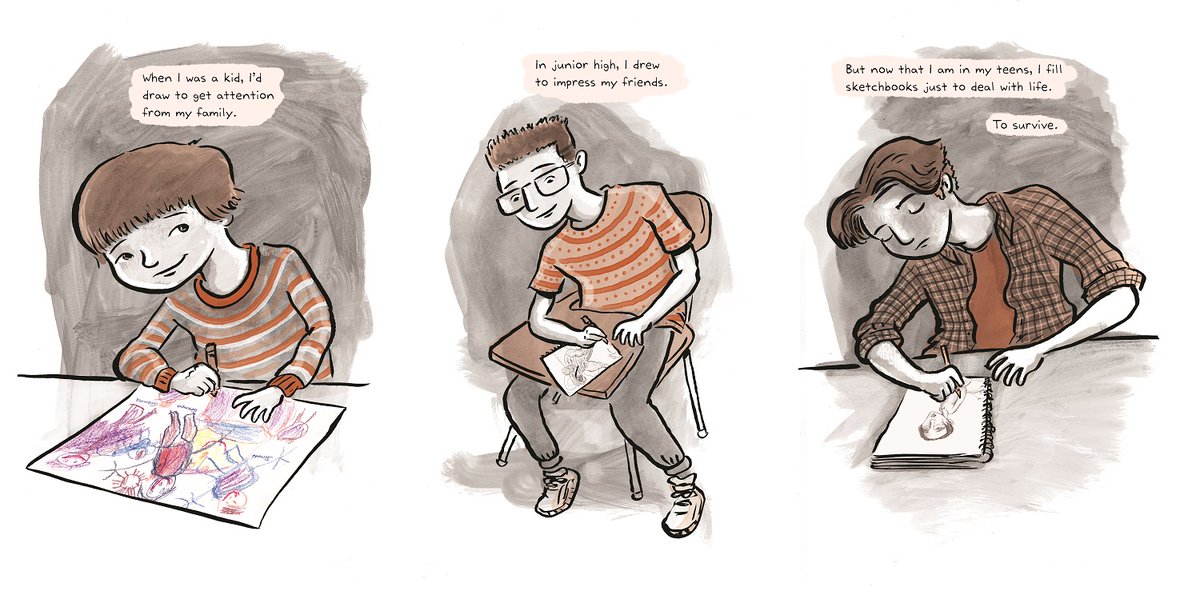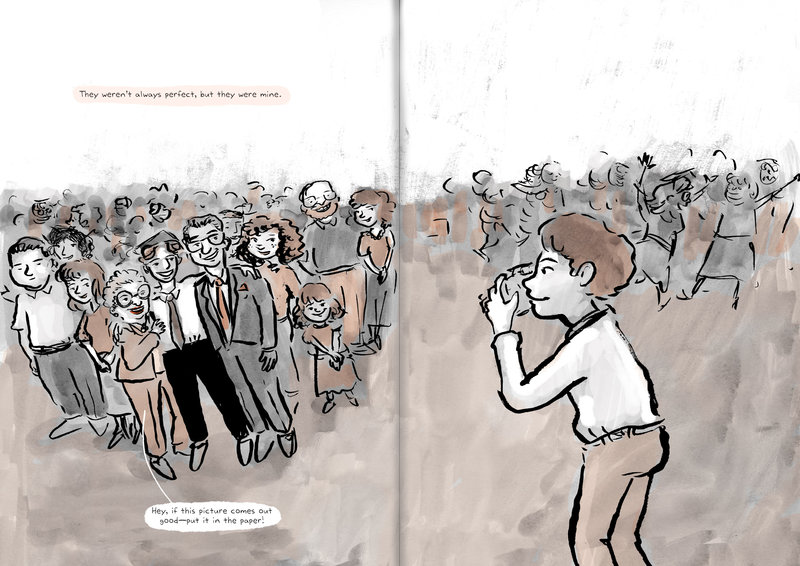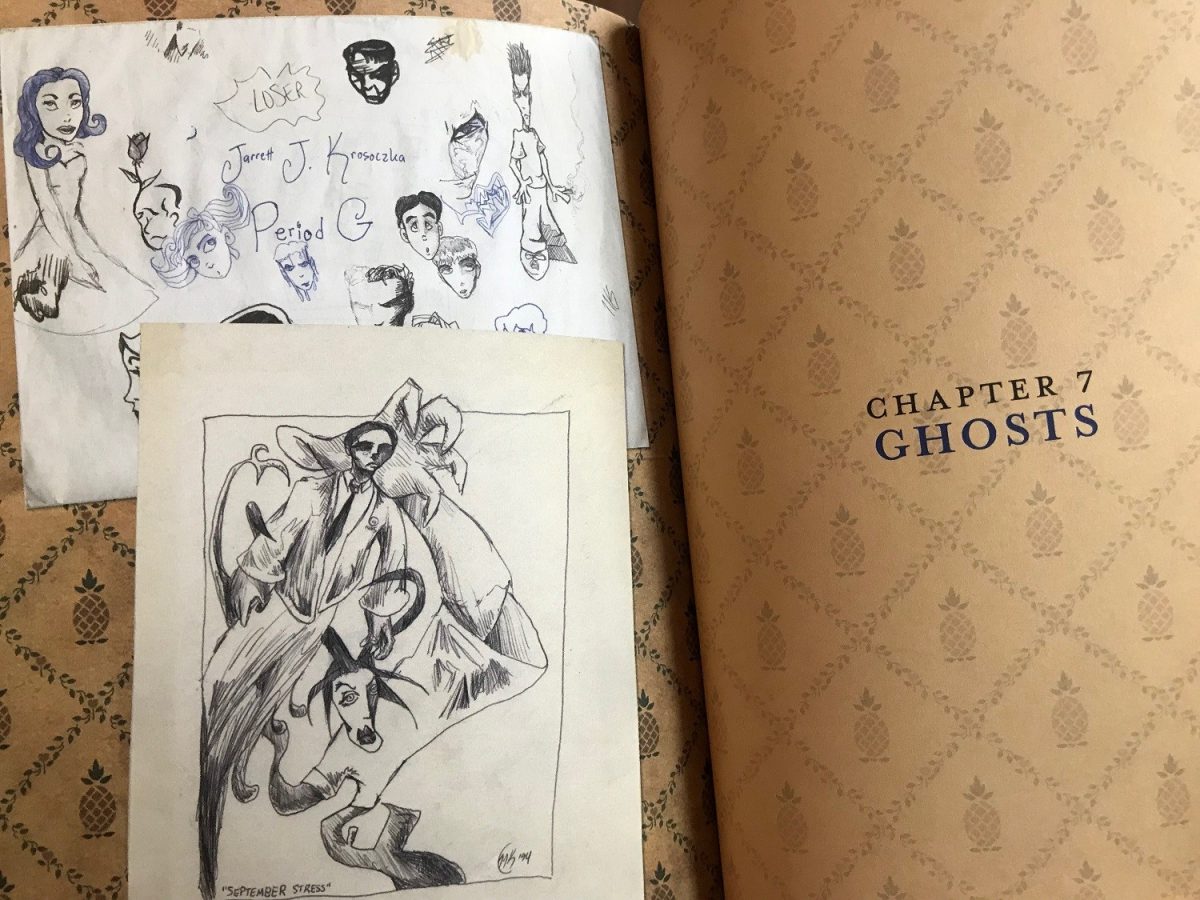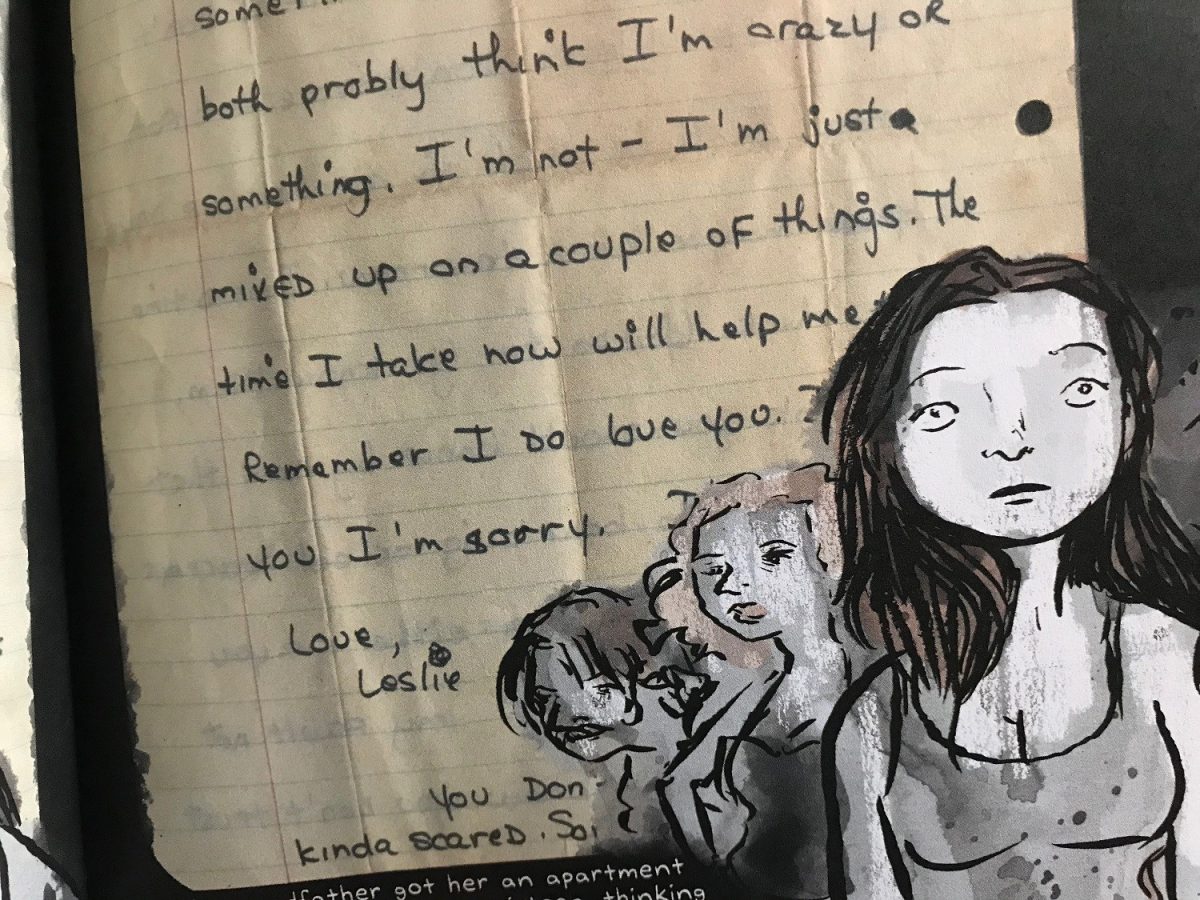
Welcome to Using Graphic Novels in Education, an ongoing feature from CBLDF designed to highlight the depth and complexity of graphic novels and to help parents and teachers raise readers. In this column, we provide teaching and discussion suggestions for the use of such books in education.
Thank you to educator Michael Gianfrancecso for his contributions to this guide.

Hey, Kiddo is the autobiographical story of author and artist Jarrett J. Krosoczka, who was born of a drug addicted mother and subsequently raised by his old fashioned but genuinely loving grandparents. Using a limited color palette and primary source documents, including actual art from the author’s childhood, the story traces Jarrett’s development from infancy to his high school graduation and examines the nature of family, love, and purpose. Tracing the impact addiction can have on the parent-child relationship across multiple generations, as well as how Jarrett’s love of drawing played a role throughout his life, the book is a balanced look at the struggles and successes that defined Jarrett’s childhood. It is a story of loss but also of the tenacity of the human spirit and the importance of a strong support system around us. The book includes an insightful author’s note and an interesting note on the art, in which Krosoczka explains the work that went into the book and expands on some of his family’s story.
Themes: Addiction, love, parental responsibility, family, creativity, finding purpose
Publisher’s Suggested Age Range: Age 12 and up
GRAPHIC NOVEL DISCUSSION AND ACTIVITY GUIDE CONTENTS
- ABOUT THE AUTHOR/ARTIST/BOOK
- PRE-READING/ANTICIPATORY ACTIVITY
- CRITICAL THINKING QUESTIONS BY COMPLEXITY
- ACTIVITIES/PROJECTS
- PROSE, POETRY, AND GRAPHIC NOVEL PAIRINGS
- ADDITIONAL RESOURCES
- COMMON CORE STANDARDS
ABOUT THE AUTHOR/ARTIST/BOOK
Hey, Kiddo is an autobiographical memoir which chronicles the early life of author and artist Jarret J. Krosoczka. The author lives with his family in Massachusetts and has written and illustrated other books, including a number of children’s books and the popular Lunch Lady and Jedi Academy graphic novel series.
In the acknowledgements for Hey, Kiddo, Krosoczka notes that when he met with his literary agent a dozen years before the book was published, “she asked me what my dream book was. I described the book that you are holding in your hands.” The book includes collages of actual art, photos, and artifacts from Krosoczka’s childhood in addition to the limited color-scale illustrations.
Hey, Kiddo is a great book to help students understand the impact of addiction and the power of a positive support system. The text offers multiple opportunities for exploring the ideas of coping skills, nontraditional and blended families, motivation for success, recovery, and coping with loss.
- Krosocka’s website: http://www.studiojjk.com/
- Book Trailer: https://youtu.be/aTQA1eFEiE4
- Krosoczka’s 2012 TED Talk “How a boy became an artist,” in which he shares more of his life story: https://www.ted.com/talks/jarrett_j_krosoczka_how_a_boy_became_an_artist?language=en
- A video and text interview with Krosoczka on the Reading Rockets website: https://www.readingrockets.org/books/interviews/krosoczka
- NPR Interview with Krosoczka, including additional family dynamics: “’Hey, Kiddo’ Aims To Help Kids With Addicted Parents Feel Less Alone” https://www.npr.org/2018/10/16/657772230/hey-kiddo-aims-to-help-kids-with-addicted-parents-feel-less-alone
Awards: Audie Award for Young Adult, Golden Kite Award for Non-Fiction for Older Readers
Nominations: National Book Award for Young People’s Literature, Audie Award for Multi-voiced Performance

PRE-READING/ANTICIPATORY ACTIVITY
Track Your Passion Watch Jarrett J. Krosoczka’s Ted Talk entitled “How a boy became an artist” (https://www.youtube.com/watch?v=_k0ywFgMpFk&t=372s) with the class. Discuss Krosoczka’s journey to success and consider what he chooses to share about his life as an artist. Invite students to consider their own personal passions—cooking, sports, dance, video games, writing, or any other hobby. Have them draw and share a timeline of their lives in which milestone events in their personal histories are marked.

CRITICAL THINKING QUESTIONS BY COMPLEXITY
- Remembering
- Which adults in Jarrett’s life encourage him to draw? How do they show their support?
- List Jarrett’s family members and their relationship to him.
- Understanding
- Where does the title of this story come from? Why do you think the author chose it?
- In Chapter 2, “Life With Leslie,” the reader learns a lot about the Krosoczka family that young Jarrett didn’t understand at the time. Describe some of the family’s challenges that are shown in text or images.
- Jarrett’s knowledge of his mother’s addiction changes as he grows older. Give an example of a time Jarrett learns something new about his mother’s addiction. Explain how it affects how he acts, how he feels, or the choices he makes.
- Applying
- Read “A Note on the Art” at the end of the book. Why do you think the author decided to include drawings, letters, and other artifacts from his childhood? How does it help tell the story?
- There are some experiences that repeat in Jarrett’s life: letters from his mother, nightmares, times his art is seen by others, times his family talked or didn’t talk about what was happening, and others. Choose two of these experiences and compare how they affect Jarrett’s life.
- The book is told through Jarrett’s point of view. What are some ways that the author lets the reader see different sides to the story?
- Analyzing
- Why do you think the author decided to tell such a personal story?
- The subtitle to Hey, Kiddo is How I Lost My Mother, Found My Father, and Dealt with Family Addiction. Look for examples of how addiction affected Jarrett. Choose three, explain what happened, and describe how Jarrett responds.
- Choose an image or series of images that you thought were powerful. Explain how the art style and color choice show the tone and mood of what is happening in the story.
- Letters and notes play an important role in Jarrett’s life. Compare a letter or note from an adult in Jarrett’s life to how that person acts and speaks. In what ways do the written messages and the adult’s actions match? How are they different?
- Evaluating
- What do you think about Jarrett’s mother Leslie? What examples from the text and images make you feel this way?
- Choose either the “Prologue” or “Chapter One: Family History.” Explain why you think Krosoczka chose to include these chapters at the beginning of his story. How would the story be different if it started with “Chapter 2: Life with Leslie”?
- In “Chapter Five: Pen to Paper,” Jarrett learns his father’s name and says, “I never want to meet him!” Why do you think Jarrett reacts this way? What makes him change his mind?
- Creating
- Jarrett’s Aunt Holly tells him, “You can apologize, but you can’t always undo what you do.” Think of a piece of advice you’ve heard from someone close or important to you. Write them a letter explaining why that advice is meaningful or has had an impact on you.
- If you wrote your own story, what life events would you focus on? Choose four events from your life. Create a title and a list of items you would include in a collage similar to the chapter headings in the book.

ACTIVITIES/PROJECTS
ASK THE AUTHOR
Have students look for interviews with Jarrett J. Krococzka in which he talks about the book and his experiences growing up with his grandparents. Have them work in small groups to study the interviews. Ask groups to make a list of new questions that they would like to ask Krococzka. As a class, agree on three questions and send them to Krococzka through his website (http://www.studiojjk.com/contact.html).
Some example interviews include:
- https://www.npr.org/2018/10/05/654596837/in-hey-kiddo-jarrett-krosoczka-draws-a-portrait-of-childhood-a-mom-s-addiction
- https://www.youtube.com/watch?v=hMv087H7Dxs
- https://www.npr.org/2018/10/16/657772230/hey-kiddo-aims-to-help-kids-with-addicted-parents-feel-less-alone
- http://www.yalsa.ala.org/thehub/2019/02/08/alamw19-recap-interviewing-jarrett-j-krosoczka-author-hey-kiddo-2019-nonfiction-award-finalist/
MUSIC AND ART
“Chapter 2: Life with Leslie” begins with the lyrics to the Loggins and Messina song, “Danny’s Song.” Kenny Loggins wrote the song for his brother Danny, who was celebrating the birth of a son. Play the song for students, and show them the lyrics. Ask them to describe why this song was included and how it reflects the action in the chapter.
Have students choose a song that reminds them of a memory. Have them draw a minicomic in which the only words are the lyrics to the song. Encourage them to not just depict their memories, but to also tie the meaning of specific lyrics to what happened.
SEL CAROUSEL
The book often focuses on the people in Jarrett’s life who are part of his positive support system, such as his grandparents, aunts, and teachers. Create a carousel by hanging several pieces of large chart paper around the room, and one piece in the center of the room. Each piece of paper on the wall should have the name of one of the characters who supported Jarrett. They can include:
- Grandpa Joe
- Grandma Shirley
- Aunt Holly and Aunt Lynn
- Mark (the teacher at Worcester Art Museum)
- Patrick
- Mr. Shilale
- Mr. Greenwood and Mrs. Casey
- Maura and Richard
On the sheet of paper at the center of the room, write Jarrett’s name.
Have students move around the room and use two to three sticky notes to write details about each supporting character. The notes can contain personal characteristics or things that the character did for or with Jarrett. Use a different color sticky note for each character.
After students have finished, have them again move around the room, removing one sticky note from each of the papers on the wall. The note they choose should have been written by someone else and should be something they find particularly important or interesting. Students should put these notes on the Jarrett paper in the center of the room. Discuss the results.
Consider the question: Where does support come from, and how does it affect our lives?
SOCRATIC DISCUSSION QUESTIONS
Engage the students in Socratic discussion in whatever form you choose (seminar, online exchange of ideas, debate, etc.) by utilizing one or more of the questions below:
- What are some of the roadblocks that Jarrett faces to his own happiness?
- How does Leslie show love for her son?
- What does the novel say about the idea of family?
- What is “normal”? How do the events of the novel change “normal” for Jarrett?
- How does the artwork complement the tone of the novel? How do the artwork and tone change from chapter to chapter and page to page?
TELL YOUR OWN STORY
Ask students to continue the “Track Your Passion” pre-reading activity, or start a comic about their lives up to now. Have them track key moments on a visual timeline and draw a minicomic about themselves that hits on at least three to five major events.
Tell students to consider the following question before they start: Who do you want to speak to and what are you trying to say? Ask students to include a statement about who they have become and why their story is worth telling.
LITERARY ANALYSIS
This can be a culminating activity for any literature based course which asks students to write a thesis driven essay about the text. Potential guidelines include:
- Persuasion: defend or propose an alternative to a character’s actions
- Comparative Analysis: compare Jarrett’s story to a character from another text
- Narrative Analysis: explore Jarrett’s hero’s journey
- Character Analysis: choose a character and analyze their portrayal in the book
- Visual Literacy: explain the nature of sequential art as a storytelling medium. This includes (but is not limited to) panel analysis, use of color, text to picture connections, and the presence of narration as part of the comic style.
- Research: examine how addiction is portrayed in media or the value of art and art education to the development of young people

PROSE, POETRY, AND GRAPHIC NOVEL PAIRINGS
Suggested Prose, Graphic Novel, and Poetry Pairings
- The Spectacular Now by Tim Tharp. Sutter Keely slowly transforms from a likeable young man to a dangerously unstable alcoholic. Consider how his story might mirror Leslie’s and how addiction can erode good intentions and plans by changing the priorities of an addicted person without them even knowing it.
- The Absolutely True Story of a Part Time Indian by Sherman Alexie: About a bright, motivated young Native American who must decide about commuting to a better but all-white school off the reservation and face ridicule by the white kids he must befriend and from his local friends he leaves behind, or remain with his friends, who are heading nowhere fast. The book takes on drug and alcohol addiction within the Native American community. Compare the struggles that Junior faces as a result of the impact that drugs and alcohol have on his family and friends.
- Iron Man: Demon in a Bottle by David Michelinie (Author), Bob Layton (Illustrator), John Romita Jr. (Illustrator), and Carmine Infantino (Illustrator). Iron Man’s famous struggle with alcoholism leaps from the page in this classic Marvel comic run. Consider how even a superhero can fall victim to addiction.
- Crank by Ellen Hopkins. Based loosely on the experiences of her daughter, Hopkins describes the harrowing impact of methamphetamine addiction on a high school girl and those around her.
- Twelve Steps to Normal by Farrah Penn. In this novel, Kira tries to resume normal life after her father goes to rehab for alcoholism.
- Beneath a Meth Moon by Jaqueline Woodson. Woodson, a former National Ambassador for Young People’s Literature, describes 15-year-old Laurel’s recovery from methamphetamine addiction.
- Heroine by Mindy McGinnis. This novel explores the opioid crisis from the perspective of a college-bound softball star who becomes addicted after a car accident.
- “Photoshopping My Sister’s Mugshot,” a poem about their sister’s addiction written and performed by Andrea Gibson. https://youtu.be/3m_sAb66lNE
- “Resolution,” a poem about dealing with addiction written and performed by Canadian poet Shane Koyczan. https://youtu.be/D0G-MyLbenE
- Honor Girl by Maggie Thrash. This memoir exploring the author’s summer at camp in her adolescence may not be about addiction, but does offer another example of the graphic memoir form.

LISTED AND ADDITIONAL RESOURCES
- Krosocka’s website: http://www.studiojjk.com/
- Book Trailer: https://youtu.be/aTQA1eFEiE4
- Krosoczka’s 2012 TED Talk “How a boy became an artist,” in which he shares more of his life story: https://www.ted.com/talks/jarrett_j_krosoczka_how_a_boy_became_an_artist?language=en
- A video and text interview with Krosoczka on the Reading Rockets website: https://www.readingrockets.org/books/interviews/krosoczka
- NPR Interview with Krosoczka, including additional family dynamics: “’Hey, Kiddo’ Aims To Help Kids With Addicted Parents Feel Less Alone” https://www.npr.org/2018/10/16/657772230/hey-kiddo-aims-to-help-kids-with-addicted-parents-feel-less-alone
- NPR Interview with Krosoczka, including additional family dynamics: “’In ‘Hey, Kiddo,’ Jarrett Krosoczka Sketches Childhood, A Mom’s Addiction” https://www.npr.org/2018/10/05/654596837/in-hey-kiddo-jarrett-krosoczka-draws-a-portrait-of-childhood-a-mom-s-addiction
- Jarrett J. Krosoczka on “Hey, Kiddo” | 2019 National Book Festival https://www.youtube.com/watch?v=hMv087H7Dxs
- #ALAMW19 Recap: Interviewing Jarrett J. Krosoczka, author of Hey, Kiddo, 2019 Nonfiction Award Finalist http://www.yalsa.ala.org/thehub/2019/02/08/alamw19-recap-interviewing-jarrett-j-krosoczka-author-hey-kiddo-2019-nonfiction-award-finalist/
ADDITIONAL RESOURCES
- American Addiction Centers’ Guide for Children of Addicted Parents https://americanaddictioncenters.org/guide-for-children
- Addiction information from Kids Health https://kidshealth.org/en/teens/addictions.html
COMMON CORE STANDARDS
Common Core State Standards (CCSS):
Following the teaching and discussion suggestions above, Hey, Kiddo can be used in classrooms to meet Common Core Standards, as detailed below. Note that this section uses the Common Core Anchor Standards for College and Career Readiness for Reading, Writing, and Speaking and Listening:
- Key ideas and details: Reading closely to determine what the texts says explicitly and making logical inferences from it; citing specific textual evidence when writing or speaking to support conclusions drawn from the text; determining central ideas or themes and analyzing their development; summarizing the key supporting details and ideas; analyzing how and why individuals, events, or ideas develop and interact over the course of the text.
- Craft and structure: Interpreting words and phrases as they are used in a text, including determining technical, connotative, and figurative meanings and analyzing how specific word choices shape meaning or tone; analyzing the structure of texts, including how specific sentences, paragraphs and larger portions of the text relate to each other and the whole; Assessing how point of view or purpose shapes the content and style of a text.
- Integration of knowledge and ideas: Integrating and evaluating content presented in diverse media and formats, including visually and quantitatively, as well as in words; delineating and evaluating the argument and specific claims in a text, including the validity of the reasoning as well as the relevance and sufficiency of the evidence; analyzing how two or more texts address similar themes or topics in order to build knowledge or to compare the approaches the author takes.
- Range of reading and level of text complexity: Reading and comprehending complex literary and informational texts independently and proficiently.
Contributors: Michael Gianfrancesco is a high school ELA teacher with 15 years experience in the classroom. He is a founding member of the LitX educational cohort. Follow him on Twitter @tryingteacher